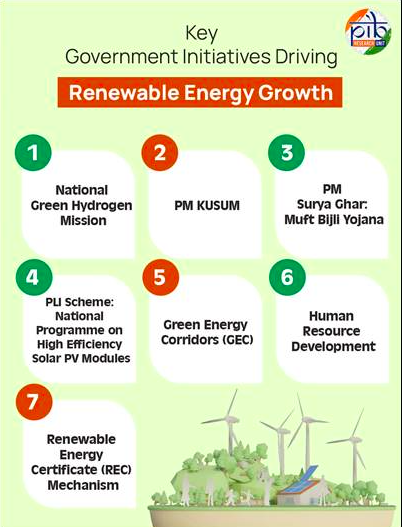5 October 2024 : PIB Summary For UPSC
1. India’s Renewable Energy Boom: Job Creation and Sustainable Growth
(Source – https://pib.gov.in/PressReleseDetail.aspx?PRID=2061902®=3&lang=1 )
| Topic: GS3 – Indian Economy – Infrastructure – Energy |
| Context |
|
Job Creation in Renewable Energy
- In 2023, India achieved a significant milestone in its renewable energy sector by reaching approximately 1.02 million jobs, as per the 2024 Annual Review by the International Renewable Energy Agency (IRENA).
- The global renewable energy workforce also saw growth, rising from 13.7 million in 2022 to 16.2 million in 2023, with India playing a crucial role in this increase.
- The report, created in collaboration with the International Labour Organization (ILO), emphasises India’s emerging leadership in clean energy and its commitment to generating green jobs that stimulate economic growth.
Economic and Employment Impacts
- The growth of renewable energy in India is pivotal not only for economic advancement but also for creating sustainable livelihoods for millions of citizens.
- The sector contributes significantly to shaping a greener future, supporting India’s journey toward energy independence and environmental sustainability, while simultaneously providing new employment opportunities across the nation.
Key Findings from the 2024 Report
- India had 1.02 million renewable energy jobs in 2023.
- Hydropower emerged as the largest employer, contributing around 453,000 jobs, representing 20% of the global total, second only to China.
- The solar PV sector employed approximately 318,600 people in on-grid and off-grid systems, with India ranking fifth globally for new installations in 2023.
- India’s operational module manufacturing capacity was 46 GW in 2023, expected to increase to 58 GW in 2024.

Annual Electricity Generation from Renewable Sources
- India’s commitment to renewable energy is reflected in annual electricity generation trends, showing a steady increase in the percentage share of renewable energy in total generation over recent years.
Major Government Initiatives
- India’s transition to sustainable energy is bolstered by key initiatives such as the National Green Hydrogen Mission, PM-KUSUM, PM Surya Ghar, and the PLI scheme for solar PV modules.
- These programs not only drive renewable energy adoption but also generate substantial job opportunities.

National Green Hydrogen Mission
- Launched in January 2023, this mission aims to establish India as a global hub for green hydrogen production, usage, and export, with a financial backing of ₹19,744 crore.
PM-KUSUM Scheme
- Launched in March 2019, this initiative focuses on providing energy and water security to farmers, while also generating employment opportunities estimated at 7.55 lakh job-years.
PM Surya Ghar: Muft Bijli Yojana
- This scheme, initiated in February 2024, offers free electricity through subsidised solar panel installations and is expected to create around 17 lakh direct jobs.
PLI Scheme for Solar PV Modules
- Aimed at achieving Giga Watt-scale manufacturing, this initiative focuses on promoting high-efficiency solar PV module manufacturing in India.
| PYQ: Do you think India will meet 50 percent of its energy needs from renewable energy by 2030 ? Justify your answer. How will the shift of subsidies from fossil fuels to renewables help achieve the above objective? Explain. (UPSC CSE (M) GS-3 2022) |
| Practice Question: Discuss the significance of the renewable energy sector in India’s economic growth and job creation, citing recent data and government initiatives. What challenges does India face in achieving its renewable energy targets, and how can they be addressed? (250 Words /15 marks) |


